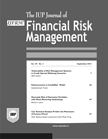|

September'10
|
Focus
The financial crisis across the globe has prompted researchers to study the various
aspects of credit in the system. In the first paper of this issue, “Vulnerability of Risk
Management Systems in Credit Spread Widening Scenarios”,
|
|
|
Articles |
| |
Vulnerability of Risk Management Systems in Credit Spread Widening Scenarios
-- Aldo Letizia
During 2008, the sudden widening of credit spreads led to a rapid decrease in the value of many financial assets,
revealing a general shortage of capital for many financial institutions, with some critical peaks that required fund injection and
public bailouts. The evidence of a substantial underestimation of the risk related to a general credit spread widening leads to
investigate the reason why risk management systems, in the early stage of the financial crisis, were not able to capture the
accumulation of such a high potential of losses. Primarily, it is questioned whether the most unexpected event was the magnitude of the
spread widening or, rather, the extent of the price reaction to that factor. The present work is mainly focused on the second
front. In particular, it explores the possibility of including in the pricing techniques of financial instruments, a treatment of
expected losses that is aligned with the most common methodologies for credit risk evaluation. The refinement of the cash flow
mapping techniques leads to detect how, in the phases of severe credit spread widening, modified duration could result in an
inaccurate measurement of interest rate risk, but primarily it does not recognize the spread risk in the floater component of a
portfolio. A slight revision of the evaluation models allows to identify two specific sensitivity measures, to interest rate and credit
spread changes, both functional to the improvement of risk management systems, in order to make them highly sensitive to the
spread risk effect.
© 2010 IUP. All Rights Reserved.
Enhancements in CreditRisk+ Model Satendramani Tiwari
According to Basel II guidelines, all financial institutions should have proper quantitative tools to manage and control the
credit risk. CreditRisk+ model developed by Credit Suisse Financial Products (CSFP) is one of the most widely used models
for calculating credit value-at-risk.
CreditRisk+ is a good choice for many banks for calculating portfolio credit
value-at-risk, because this model requires limited amount of inputs and is formulated with limited assumptions. There has been a large
amount of research work on CreditRisk+ to enhance its capabilities and features. This paper aims to suggest a parallel
computing-based Monte-Carlo simulation, for a very large portfolio using the
CreditRisk+ infrastructure, to calculate the portfolio
loss distribution.
© 2010 IUP. All Rights Reserved.
Downside Risk of Derivative Portfolios with Mean-Reverting Underlyings
-- Patrick L Leoni
The paper analyzes the sensitivity of the downside risk of a standard derivatives portfolio to a change in the
mean-reversion level of its underlyings. From Monte-Carlo simulation, it is found that the higher the intensity of mean-reversion, the
lower the probability of reaching a predetermined loss level. This phenomenon appears to be more statistically significant for
large loss levels. It is also found that the higher the mean-reversion intensity of the underlyings, the longer the expected time to
reach the given loss levels. The simulations suggest that selecting underlyings with high mean-reversion effect is a natural way to
reduce the downside risk of the widely traded assets, without involving costly and restrictive managerial intervention.
© 2010 IUP. All Rights Reserved.
Can Technical Analysis Predict the Movement
of Futures Prices?
-- Noor Azlinna Azizan and Jacinta Chan Phooi M'ng
This paper presents a study of technical analysis trading rules that generate abnormal returns for futures prices. It
reports abnormal returns over and above that generated by the passive buy-and-hold policy for FKLI, FCPO, Soyoil, Soybean
and Corn futures for the periods tested. This research devises a new technical analysis trading model, Bollinger Bands Z-Test
(BBZ), using standard deviation. It proposes that BBZ attempts to capture large price movements which happen beyond
1 standard deviation. The mechanical buy signal is above +1 standard deviation and sell signal is below - 1 standard
deviation. For the period 12/15/1995-12/31/2008, BBZ yields a return of 1,048.6 points for FKLI in comparison to the passive
buy-and-hold policy which yields a negative return of _110.5 points. The returns obtained using optimized BBZ for FCPO,
Soyoil, Soybean and Corn futures for the year 2008 are 1,119, 27, 522 and 328 points respectively.
© 2010 IUP. All Rights Reserved.
|


